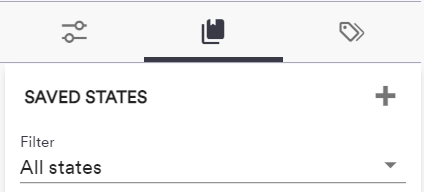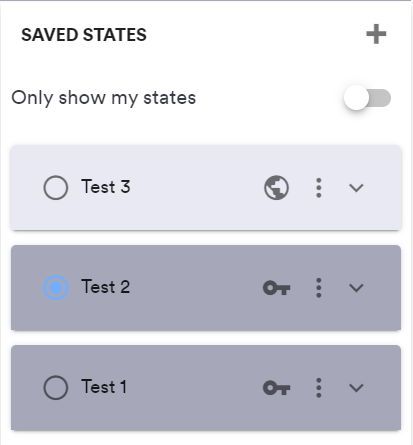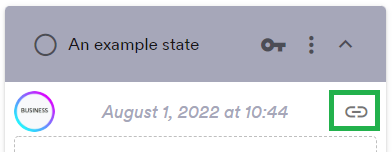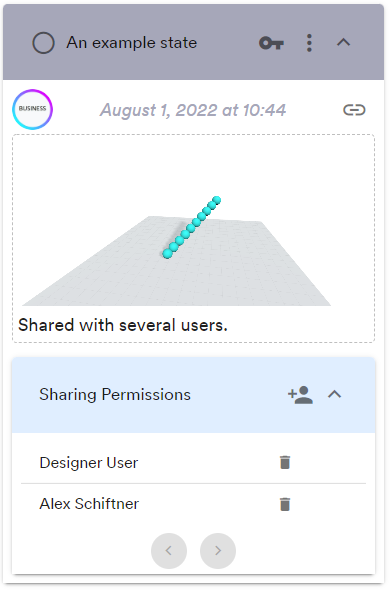Saved States
Creating a state
In order to create a new saved state, navigate to the “Saved States” section in the model view page. This section is part of the same panel that contains the parameters and outputs of the model:

The process to create a saved state goes as follows:
Setup the model in the state you want to save, by defining the parameter values and camera position according to your needs.
Once this is done, click on the “+” button in the “Saved States” section. A dialog opens which lets you define some additional properties for the state:
Property | Description |
|---|---|
Name | The name that will be used to identify the state in the panel and in the API (up to 50 characters). |
Visibility | If you are the owner of a model, you have two visibility options when creating saved states:
If you are not the owner of a model but have access to it, because it is “Public”, part of your “Organization” or because it was shared with you, you can list and load all “Public” saved states associated with the model. You can also create “Private” saved states that are only visible to you. |
Iframe visibility | Check the box “Show Saved State in embedded iframes” if you want to include this state in the “Saved States” section of the iframe. Note that you can choose to hide the Saved State section altogether in the iframe settings. |
Description | A description of the state (up to 250 characters). |
When clicking on “Create”, the state is saved using the above-defined properties, as well as the active parameters values and camera position. It will instantly appear in the list of states in the panel.
Updating a state
All properties above can be update after the state is created. Use the context menu and choose the “Update” option to update the name, visibility and description of the state. The screen for editing a saved state contains two additional checkoxes:
Update parameter values: if this option is selected, the parameter values of the saved state will be updated using the currently active ones in the viewer.
Update thumbnail using the active camera position: if this option is selected, the thumbnail associated with the saved state will be updated by taking a screenshot of the current viewer state.
Update camera settings: if this option is selected, the default camera position and target will be updated once the saved state is saved again.
Deleting a state
Use the context menu and choose the “Delete” option to permanently delete the state for yourself and anyone who has access to it.
Loading a state
You can easily navigate between saved states and load a new one by clicking on the radio button on the left of the element in the list. The active state is shown with an active radio button:

Direct link to a state
The “link” button at the top of the state section generates a link to the model with the current saved state pre-loaded:

It can be sent to anyone who has access to the state. In particular, links to public states can be opened by anyone, even without a ShapeDiver account. Links to other states with restricted visibilities will be accessible with the appropriate permissions.
Sharing a state
This feature is only available with a paid ShapeDiver subscription.
Click on the arrow on the right of the state in the list to open details, including the screenshot and description of the state defined by its owner.
If you have created a state yourself, you have access to an additional menu that allows you to manage the list of people you have shared the state with:

Click on the “Share” button on the section title to search for a user and start sharing the state with them. All users who have a public profile, as well as users from your organization if you are part of one, will be searchable in the dialog.
Once you have shared the state, the user will appear in the list below. You can always revoke the sharing permission by clicking on the “Delete” icon next to a name in the list.
Filtering
The dropdown at the top of the panel lets you filter which states to list in the section:
“All states”: Displays your own states as well as all the other states you have access to (public states and states that other users shared with you).
“My states”: Displays only the states you created
“Shared with me”: Displays only the states other users shared with you using the saved state sharing feature (see previous section).
